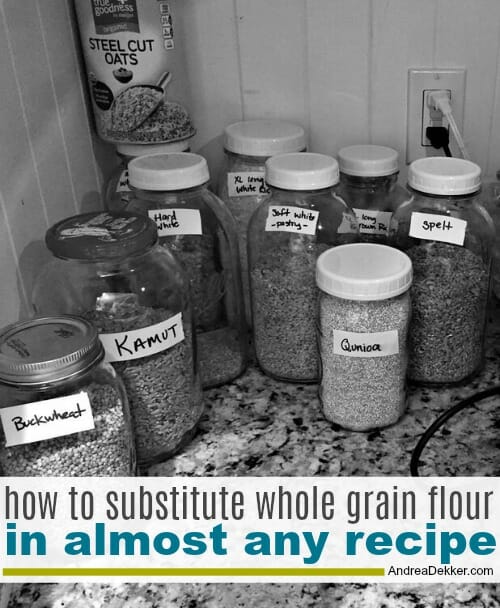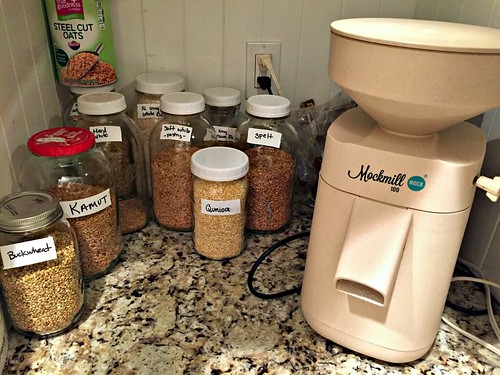
For the last 5+ months, I’ve been cooking, baking, and eating whole grains every single day.
I’ve read and learned so much, I’ve made many amazingly delicious foods, and I’ve had some total flops (see below!)

Most of the time, I’ve enjoyed this learning and experimenting process, but Dave will tell you I’ve also been extremely frustrated on more then one occasion!

As someone who has baked exclusively with all-purpose flour my entire life, and has thoroughly enjoyed white bread, white rice, white pasta, white tortillas, etc., I honestly have NO idea where my desire to integrate whole grains into my kitchen started.
I’m really not a health food nut, I was not raised on whole grain, and I’m still a strong advocate for “all things in moderation” (including white flour).
For me, it has felt more like a challenge to conquer and a “project” to work on over the winter months when house and yard projects are lacking!
Whatever the case, I have been somewhat obsessed (in the best possible use of that word!) with learning as much as I can about whole grains… and wow, have I learned a lot!
I won’t bore you with too many details… but I WILL share a super simple way to substitute whole grain flour for all purpose in almost any of your favorite recipes — giving you more fiber and more nutrients with very little hassle or extra effort on your part!
How to Substitute Whole Grain Flour in Almost Any Recipe:
Simply swap UP TO HALF of the all-purpose flour for whole grain / whole wheat flour and make the rest of the recipe exactly as written (allowing roughly 10-15 minutes for the batter/dough to “rest” and the flour to absorb the liquid before baking).
Any time I’ve substituted half whole grain, my recipe has still turned out wonderfully.
Yes, there are some flavor differences. Yes, the color of the finished food is often darker. Yes, some of the foods are slightly heavier. BUT, not in a bad way — just a different way.
All my cakes, cookies, quick breads, muffins, rolls, pancakes, waffles, corn breads, brownies, yeast breads, etc. turn out wonderfully with no other alterations, as long as I don’t substitute more than 50% of the all purpose flour for whole grain or whole wheat flour.
This means that virtually any recipe in your recipe box, any recipe in your favorite cookbook, and any recipe on my blog can be made using 50% whole grain flour without wondering or worrying if the finished product will turn out.
If you want to substitute more than 50% whole grain flour (something I regularly do) I would highly recommend starting with pancakes, or quick breads.
Those recipes are the most “forgiving” in terms of tweaking them and swapping out ingredients. If your batter seems a little dry or thick, add more milk or water. If it seems too runny, add a bit more flour and let it rest for 10-15 minutes again.
If you want to try your hand at 100% whole grain yeast bread, you will most likely want to do a little research first. I have found that I often need to alter the amount of liquid in the recipes when I’m using 100% whole grain. I also frequently add dough conditioners, and I sometimes let the flour/water mixture rest for several hours before adding the yeast, salt, oil, etc. It just depends on the recipe.
There are SO many different variables to tweak when making yeast breads — which is why using 100% whole grain has been SO frustrating for me at times!!
If you want to experiment with whole grain and turn it into a little hobby like I have, go for it!
However, if you’d simply like to add a little more fiber and nutrients in your everyday cooking and baking, I’d suggest simply replacing 50% of the all purpose flour in any of your favorite recipes with whole grain flour. Your family probably won’t even notice the difference!
One Final Tip:
I usually grind my grain immediately before baking, but if I have extras, or if I buy bags of already ground flour, I store them in the freezer as whole grain flour goes rancid quite quickly (in as little as one week).














Laura says
Thanks for sharing Andrea! Does this tip also work if your recipe uses self rising flour instead of all purpose?
Andrea says
Self-rising flour is totally different — so I’m not exactly sure how it would convert.
I do know how to “make” self-rising flour from whole grain flour that I grind myself:
1 cup self rising flour =
1.25 c. freshly ground whole grain flour +
1.5 t. baking powder +
1/2 t. baking soda +
1/2 t. salt
Not sure if this is helpful or not 🙂
JJ says
What grains do your kids eat more of or is it a toss-up? What grains would you suggest starting with first? Thanks! This is very interesting to me!!!
Andrea says
oats are pretty easy with kids — also wild rice, quinoa, and barley.
Of course, wheat is pretty easy too — baked into any type of bread, pancake, waffles, etc.
Margaret says
I’ve been baking with 100% whole wheat flour for years now–with the caveat that I almost never bake yeast bread anymore. In the last few months I have been trying to overcome my fear of pastry (really. I was asked to bake pies for a wedding last summer, and begged to make cookies instead.) I have found that I can make good, flaky pie crust with 100% ww flour, but I need to add quite a bit more water than the recipe calls for to get the right texture, and it is harder to handle. A friend suggested rolling the dough between to sheets of waxed paper, and that helps.
Have you tried pie crust yet?
Andrea says
yum… pie!
I honestly don’t make much pie anymore (except ice cream and pudding pies) because the kids don’t eat it and then Dave and I are stuck eating a crazy amount of pie. I usually only make it for special occasions or when we have people over.
Natalia says
Thanks for sharing! I am impressed by the variety of grains you use!!!! I’d love to start grinding my own flour (one day…) You truly are an inspiration!
Andrea says
thanks 🙂 Yes, it’s VERY easy to use lots of different grains once you can grind them yourself. It’s very economical too!
Jennifer says
Yes, gradual swapping is the key to getting family on board. Cookies are easy like the pancakes and quick breads. Cookies don’t need much rise, and if there are chocolate chips (I use dark) they just get gobbled up. Dried fruit works well, too. I put all kinds of ground grains and seeds and nuts in a cookie recipe and some dark chocolate chips and/or dried cranberries/blueberries/raisins, etc. I only use honey or maple syrup to sweeten, and some times coconut sugar, so pretty healthy, not absolutely. We are on the go a lot (to the beach—haha!) I feel way better about them than store bought “health” bars, but calling them cookies makes my family perk up to them.
Nicola says
Thanks for posting about your switch to whole grains! You have inspired me so much. Yesterday I made pizza and used 4 cups whole wheat flour and 1 cup of oats that I blended into a flour in my magic bullet. Tasted great, and all because of you!!!
Andrea says
yay — I’m so happy to read this! Thanks for sharing 🙂